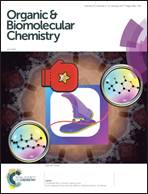Tuning the hybridization properties of modified oligonucleotides: from flexible to conformationally constrained phosphonate internucleotide linkages†
Abstract
The concept of conformational restriction leading to the preorganization of modified strands has proven to be successful and has afforded nucleic acid analogues with many interesting properties suitable for various biochemical applications. We utilized this concept to prepare a set of constrained oligonucleotides derived from 1,4-dioxane and 1,3-dioxolane-locked nucleoside phosphonates and evaluated their hybridization affinities towards their complementary RNA strands. With an increase of ΔTm per modification up to +5.2 °C, the hybridization experiments revealed the (S)-2′,3′-O-phosphonomethylidene internucleotide linkage as one of the most Tm-increasing modifications reported to date. Moreover, we introduced a novel prediction tool for the pre-selection of potentially interesting chemical modifications of oligonucleotides.



 Please wait while we load your content...
Please wait while we load your content...